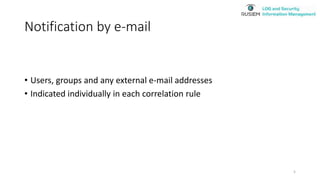RuSIEM vs SOC (En)
- 1. support@rusiem.com https://rusiem.com RuSIEM vs SOC (Security Operation Center) 2018
- 2. Existing methods in the current versions • Forwarding events by Syslog (TLS) to all, by filter or criticality • Notification by e-mail according to the correlation rule • Formation and sending of events when triggered the correlation rule • Running the script and the script in correlation • The hierarchical structure of RuSIEM • The "only SOC" option with the installation of collectors or storage nodes on the Customer's side with management of SOC operators • Access to incidents, events via RuSIEM API 3
- 3. Forwarding events by Syslog • Plain text or Syslog TLS • All or by filter (field, host, source, criticality, etc.) • Filtered events with RuSIEM symptomatic ® • Format: RAW, normalized, CEF 4
- 4. Notification by e-mail • Users, groups and any external e-mail addresses • Indicated individually in each correlation rule 5
- 5. Formation and sending of events when triggered correlation rule • The text of the event is indicated individually in each correlation rule • By default, notifications are used for system users (by group / user / role) 6
- 6. Run script / script in correlation • Local execution of the script / command individually specified for the correlation rule • Content of the script - any of your content • When the correlation rule is triggered • The transfer of variables with correlation is supported (for example, $ host, $ src.ip, $ user.name) 7
- 7. The hierarchical structure of RuSIEM • Distributed event search without consolidating events into a single repository • Distributed correlation without consolidation of events • Using a multi-level model with different storage periods, its own correlation rules • Linked and unrelated levels of the model • Remote management of nodes from a single console 8
- 9. Option "only SOC" • The Customer only installs nodes to collect and(or) store events • Control is carried out only from SOC • Access to client node management can be restricted to SOC personnel and only access to events is provided 10
- 11. Access to incidents, events via API • Managing the settings of the node remotely from a single console • Manage any settings remotely • Full management of incidents, symptoms, correlation rules remotely • Authentication and authorization through tokens and role model 12
- 12. Contacts: Web: https://www.rusiem.com Telegram: https://t.me/rusiem Facebook: https://www.facebook.com/rvsiem Info@support: support@rusiem.com THANK YOU FOR ATTENTION 13












